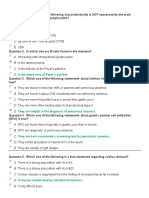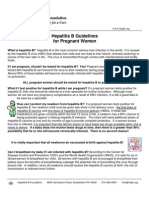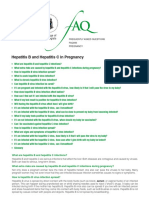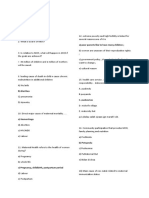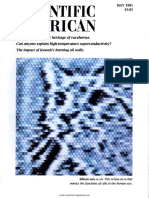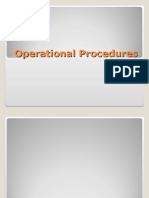Peptic Ulcer
Peptic Ulcer
Uploaded by
mehnoor kaurCopyright:
Available Formats
Peptic Ulcer
Peptic Ulcer
Uploaded by
mehnoor kaurOriginal Title
Copyright
Available Formats
Share this document
Did you find this document useful?
Is this content inappropriate?
Copyright:
Available Formats
Peptic Ulcer
Peptic Ulcer
Uploaded by
mehnoor kaurCopyright:
Available Formats
Peptic
ulcer mcqs pdf
What is peptic ulcer how is peptic ulcer caused class 10. Peptic ulcer menu. Types of peptic ulcer pdf.
Q1. Which pathogen is strongly associated with peptic ulcer? (a) Bifidobacterium bifidum (b) Escherichia coli (c) Helicobacter pylori (d) Faecalibacterium prausnitzii Q2. Gastric ulcers are most common in younger patients (a) True (b) False Q3. How do NSAIDs contribute to peptic ulcer formation?
(a) By burning holes directly in the gastric mucosa when they hit the stomach. (b)Increasing acid production (c) Decreasing prostaglandin synthesis HOME HEALTH TOPICS Healthy Living SYMPTOMS EMERGENCIES RESOURCES NEWS ABOUT 10 Questions | Attempts: 61514 Which of the following is NOT a causative agent for a peptic ulcer?
What are the complications of a Peptic Ulcer?
When HP is the cause of PUD, the ulcer disease can be eradicated with The lifetime risk of ulcer disease is Both gastric ulcers and H.pylori infection are highly associated with _________. Ulcerations typically occur in regions bathed with acid/pepsin, such as the What often describes the pain of PUD? Sharp, knife-like. Radiates to the right shoulder
Dull, achy. Localized to the stomach. Diffuse, joint arthralgia. Burning or gnawing. Radiates to the back. Complications of PUD include bleeding, perforation, and penetration.
1.) Bleeding typically manifests as _________________. 2.) PUD is the most common cause of nonhemorrhagic GI bleeds/ What is best used for detecting small or healing ulcers? What is the treatment for PUD in addition to discontinuing irritating factors? Bismuth subsalicylate plus tetracycline Stomach Bacteria Influenza Abdomen In order to continue
enjoying our site, we ask that you confirm your identity as a human. Thank you very much for your cooperation. This is a quiz that contains NCLEX review questions for peptic ulcer disease. As a nurse providing care to a patient with peptic ulcer disease, it is important to know the signs and symptoms, pathophysiology, medications, nursing
management, diet education, and complications. In the previous NCLEX review series, I explained about other GI disorders you may be asked about on the NCLEX exam, so be sure to check out those reviews and quizzes as well. (NOTE: When you hit submit, it will refresh this same page. Scroll down to see your results.) Peptic Ulcer Disease NCLEX
Questions 1. In the stomach lining, the parietal cells release _________ and the chief cells release __________ which both play a role in peptic ulcer disease. A. pepsin, hydrochloric acid B. pepsinogen, pepsin C. pepsinogen, gastric acid D. hydrochloric acid, and pepsinogen 2. A patient has developed a duodenal ulcer. As the nurse, you know that which of
the following plays a role in peptic ulcer formation. Select ALL that apply: A. Spicy foods B. Helicobacter pylori C. NSAIDs D. Milk E. Zollinger-Ellison Syndrome 3. You’re educating a group of patients at an outpatient clinic about peptic ulcer formation. Which statement is correct about how peptic ulcers form? A. “An increase in gastric acid is the
sole cause of peptic ulcer formation.” B.
“Peptic ulcers can form when acid penetrates unprotected stomach mucosa. This causes histamine to be released which signals to the parietal cells to release more hydrochloric acid which erodes the stomach lining further.” C. “Peptic ulcers form when acid penetrates unprotected stomach mucosa. This causes pepsin to be released which signals to
the parietal cells to release more pepsinogen which erodes the stomach lining further.” D. “The release of prostaglandins cause the stomach lining to breakdown which allows ulcers to form.” 4. Your patient is diagnosed with peptic ulcer disease due to h.pylori. This bacterium has a unique shape which allows it to penetrate the stomach mucosa. You
know this bacterium is: A. Rod shaped B. Spherical shaped C. Spiral shaped D. Filamentous shaped 5. Helicobacter pylori can live in the stomach’s acidic conditions because it secretes ___________ which neutralizes the acid. A. ammonia B. urease C.
carbon dioxide D. bicarbonate 6. The physician orders a patient with a duodenal ulcer to take a UREA breath test. Which lab value will the test measure to determine if h.
pylori is present? A. Ammonia B. Urea C.
Hydrochloric acid D. Carbon dioxide 7. A patient arrives to the clinic for evaluation of epigastric pain. The patient describes the pain to be relieved by food intake. In addition, the patient reports awaking in the middle of the night with a gnawing pain in the stomach. Based on the patient’s description this appears to be what type of peptic ulcer? A.
Duodenal B. Gastric C.
Esophageal D. Refractory 8. A patient with chronic peptic ulcer disease underwent a gastric resection 1 month ago and is reporting nausea, bloating, and diarrhea 30 minutes after eating.
What condition is this patient most likely experiencing? A. Gastroparesis B. Fascia dehiscence C. Dumping Syndrome D. Somogyi effect 9. Thinking back to the patient in question 8, select ALL the correct statements on how to educate this patient about decreasing their symptoms: A. “It is best to eat 3 large meals a day rather than small frequent
meals.” B. “After eating a meal lie down for 30 minutes.” C. “Eat a diet high in protein, fiber, and low in carbs.” D. “Be sure to drink at least 16 oz. of milk with meals.” 10. A patient is recovering from discomfort from a peptic ulcer. The doctor has ordered to advance the patient’s diet to solid foods. The patient’s lunch tray arrives. Which food should
the patient avoid eating? A. Orange B. Milk C. White rice D. Banana 11. Which statement is INCORRECT about Histamine-receptor blockers? A.
“H2 blockers block histamine which causes the chief cells to decrease the secretion of hydrochloric acid.” B. “Ranitidine and Famotidine are two types of histamine-receptor blocker medications.” C. “Antacids and H2 blockers should not be given together.” D. All the statements are CORRECT. 12. You are providing discharge teaching to a patient
taking Sucralfate (Carafate). Which statement by the patient demonstrates they understand how to take this medication? A. “I will take this medication at the same time I take Ranitidine.” B. “I will always take this medication on an empty stomach.” C. “It is best to take this medication with antacids.” D. “I will take this medication once a week.” 13.
Select all the medications a physician may order to treat a H. Pylori infection that is causing a peptic ulcer? A. Proton-Pump Inhibitors B. Antacids C. Anticholinergics D. 5-Aminosalicylates E. Antibiotics F. H2 Blockers G. Bismuth Subsalicylates 14.
A physician prescribes a Proton-Pump Inhibitor to a patient with a gastric ulcer. Which medication is considered a PPI? A. Pantoprazole B. Famotidine C. Magnesium Hydroxide D. Metronidazole 15. A patient with a peptic ulcer is suddenly vomiting dark coffee ground emesis. On assessment of the abdomen you find bloating and an epigastric mass in
the abdomen. Which complication may this patient be experiencing? A. Obstruction of pylorus B. Upper gastrointestinal bleeding C. Perforation D. Peritonitis Answer Key: 1. D 2. B, C, E 3. B 4. C 5. B 6.
D 7. A 8. C 9. B, C 10. A 11. A 12.
B 13. A, E, F, G 14. A 15.
B You're Reading a Free Preview Page 2 is not shown in this preview. Drug Biotechnology Multiple Choice Questions & Answers on “Pharmacotherapy of Peptic Ulcer – 2”. 1. Which enzyme of H. pyloric helps it to grow in the acidic medium of the stomach?a) Ureaseb) Amylasec) Proteased) Acid HydrolasesAnswer: aClarification: H. pylori primarily
colonize in the antrum of the stomach it resides mainly within the gastric mucus. H. pylori have a high activity of the enzyme urease which enables it to colonize in the stomach. Infection can spread through fecal route. Infection thought to occur between parents and young children. 2. How to diagnose infection by H. pylori?a) Histology and cultureb)
Antibody testc) Urease CLO testd) Antibody test, Urease CLO test, Histology and cultureAnswer: dClarification: The majority of cases of peptic ulcer disease are related to H. pylori. The diagnosis of H. pylori infection must be confirmed prior to initiation of therapy. The methods can be histology and culture, antibody test, urease CLO test. H. pylori
have a high activity of the enzyme urease which enables it to colonize in the stomach. Infection can spread through fecal route.
Infection thought to occur between parents and young children. 3. Which cells are also known as chief cells?a) Parietal cellsb) Mucous neck cellsc) Peptic cellsd) Superficial epithelial cellsAnswer: cClarification: Peptic cells in the stomach lining is also known as a chief cell. The stomach lining has parietal cells that secrete acid, Goblet cells, mucous
neck cells, superficial epithelial cells.
All these cells can be found in the body and fundus of the stomach. 4. How neuronal regulation of gastric acid is done?a) Acetylcholineb) Gastrinc) Histamined) CNSAnswer: aClarification: Neuronal control is done by secretion of acetylcholine by the cholinergic neuron. Hormonal control of gastric acid is done by gastrin. Paracrine control of gastric
acid is done by histamine secreted by enterochromaffin-like cells. 5.
How hormonal regulation of gastric acid is done?a) Acetylcholineb) Gastrinc) Histamined) CNSAnswer: bClarification: Neuronal control is done by secretion of acetylcholine by the cholinergic neuron. Hormonal control of gastric acid is done by gastrin. Paracrine control of gastric acid is done by histamine secreted by enterochromaffin-like cells. 6.
Which will be the correct option for the marked place?a) Acetylcholineb) Gastrinc) Histamined) Hydrogen ionsAnswer: aClarification: Cholinergic neuron secretes acetylcholine that through circulation goes and bind to the muscarinic receptor in the parietal cell secrete acid into the gastric lumen.
Enterochromaffin-like cells secrete histamine which again goes and binds to the H2 receptor and through the cAMP pathway helps the parietal cell to secrete acid. Gastrin secreted by Antral G cell is the hormonal control of acid secretion by the parietal cell.
Gastrin, Histamine, and acetylcholine switch on the proton pump thus pumping H+ ions to produce acid in the gastric lumen.
7. Which will be the correct option for the marked place?a) Mucous cellsb) Parietal cellsc) Enterochromaffine like cellsd) Antral G cellAnswer: bClarification: Cholinergic neuron secretes acetylcholine that through circulation goes and bind to the muscarinic receptor in the parietal cell secrete acid into the gastric lumen.
Enterochromaffine like cells secrete histamine which again go and bind to the H2 receptor and through the cAMP pathway helps the parietal cell to secrete acid. 8. Which will be the correct option for the marked place?a) Acetylcholineb) Gastrinc) Histamined) AcidAnswer: dClarification: Enterochromaffine like cells secrete histamine which again go
and bind to the H2 receptor and through the cAMP pathway helps the parietal cell to secrete acid. Gastrin secreted by Antral G cell is the hormonal control of acid secretion by parietal cell. Acid in our stomach is secreted by the parietal cells. Mucous is secreted by the goblet cells. 9. Which will be the correct option for the marked place?a)
Acetylcholineb) Gastrinc) Histamined) Hydrogen ionsAnswer: bClarification: Gastrin secreted by Antral G cell is the hormonal control of acid secretion by parietal cell. Gastrin, Histamine and acetylcholine switch on the proton pump thus pumping H+ ions to produce acid in the gastric lumen. Acid in our stomach is secreted by the parietal cells.
Mucous is secreted by the goblet cells. 10. Which will be the correct option for the marked place?a) Mucous cellsb) Red blood cellc) Enterochromaffine like cellsd) Antral G cellAnswer: cClarification: Enterochromaffine like cells secrete histamine which through circulation again go and bind to the H2 receptor and through the cAMP pathway helps the
parietal cell to secrete acid.
Gastrin secreted by Antral G cell is the hormonal control of acid secretion by parietal cell. 11. Which will be the correct option for the marked place?a) Acetylcholineb) Gastrinc) Histamined) Hydrogen ionsAnswer: cClarification: Cholinergic neuron secretes acetylcholine that bind to the muscarinic receptor in the parietal cell secrete acid into the
gastric lumen. Enterochromaffine like cells secrete histamine which again bind to the H2 receptor and through the cAMP pathway helps the parietal cell to secrete acid. Gastrin secreted by Antral G cell is the hormonal control of acid secretion by parietal cell. 12. Which will be the correct option for the marked place?a) Mucous cellsb) Red blood cellc)
Enterochromaffine like cellsd) Antral G cellAnswer: dClarification: Cholinergic neuron secretes acetylcholine that through circulation goes and bind to the muscarinic receptor in the parietal cell secrete acid into the gastric lumen. Enterochromaffine like cells secrete histamine which again go and bind to the H2 receptor and through the cAMP
pathway helps the parietal cell to secrete acid. Gastrin secreted by Antral G cell is the hormonal control of acid secretion by parietal cell. Gastrin, Histamine and acetylcholine switch on the proton pump thus pumping H+ ions to produce acid in the gastric lumen.
13. Inhibition of H+, K+-ATPase blocks both basal and stimulated acid secretion.a) Trueb) FalseAnswer: aClarification: H+, K+-ATPase is located in the apical membrane of the oxyntic cell along the secretory canaliculi. The pump requires large amounts of energy that is supplied by intracellular ATP that is why inhibition of H+, K+-ATPase blocks
both basal and stimulated acid secretion. 14. Cimetidine is an H1 receptor antagonist.a) Trueb) FalseAnswer: bClarification: Cimetidine is an H2 receptor antagonist thus used in the treatment of peptic ulcer. It inhibits basal acid secretion of the stomach including nocturnal secretion. It is readily absorbed after oral administration and has a brief
duration of action from 4-8 hr. To practice all areas of Drug Biotechnology,
You might also like
- Digestion - Nursing Test QuestionsDocument44 pagesDigestion - Nursing Test QuestionsRNStudent1100% (1)
- Soal MCQDocument39 pagesSoal MCQYhoooga100% (2)
- Hi-Yield Notes in AnatomyDocument31 pagesHi-Yield Notes in AnatomyJohn Christopher Luces100% (4)
- Budget of Work In-Nail Care - 7Document8 pagesBudget of Work In-Nail Care - 7JuvyGonzales100% (4)
- SBI241 - Week 8 Kahoot's QuizDocument5 pagesSBI241 - Week 8 Kahoot's Quizjessicalrogers01No ratings yet
- Final Test Session 2 Professional BSN, 4 Year Programme Subject: Adult Health Nursing I Topic: Unit I (Gastrointestinal System)Document8 pagesFinal Test Session 2 Professional BSN, 4 Year Programme Subject: Adult Health Nursing I Topic: Unit I (Gastrointestinal System)You TuberNo ratings yet
- A Client Care StudyDocument27 pagesA Client Care StudyTestimony WilliamNo ratings yet
- Human Health and DiseasesDocument85 pagesHuman Health and DiseasesOnly CrypticNo ratings yet
- Assignment 0 SolutionDocument5 pagesAssignment 0 SolutionShoby SunnyNo ratings yet
- GIT, HBS, Nutrition, Metabo: Department of Community Medicine Mbbs Ii Year Annual Exam 2002 MCQDocument2 pagesGIT, HBS, Nutrition, Metabo: Department of Community Medicine Mbbs Ii Year Annual Exam 2002 MCQEliza SparkNo ratings yet
- Chapter 326Document7 pagesChapter 326debNo ratings yet
- Quiz 1Document5 pagesQuiz 1Happy Tamil'ansNo ratings yet
- Elca/Cspm Final Exam 2007 14 July, 2007Document23 pagesElca/Cspm Final Exam 2007 14 July, 2007Dr Atef Hadedy100% (3)
- Helicobacter Pylori (H. Pylori) Infection FactsDocument38 pagesHelicobacter Pylori (H. Pylori) Infection FactsPieter Steenkamp100% (1)
- Health Assignment6Document7 pagesHealth Assignment6api-275667839No ratings yet
- CHN by Shah - EditedDocument19 pagesCHN by Shah - EditedMuhammad ShahbazNo ratings yet
- Assignment 060 CollibacilosisDocument6 pagesAssignment 060 Collibacilosisgameinitiative837No ratings yet
- Bacteriology Mcqs Mashup by AmaLunduDocument228 pagesBacteriology Mcqs Mashup by AmaLunduGreatson Smith ChansaNo ratings yet
- Multiple Choice Questions (GIT)Document4 pagesMultiple Choice Questions (GIT)Ahmed Ali100% (1)
- Pregnancy HepBDocument2 pagesPregnancy HepBJonah CarloNo ratings yet
- Multiple Choice Questions (GIT)Document4 pagesMultiple Choice Questions (GIT)Ahmed AliNo ratings yet
- (Year) : Type The Document TitleDocument8 pages(Year) : Type The Document TitleMohamoud MohamedNo ratings yet
- CHN EvaluationDocument6 pagesCHN EvaluationDarlyn DocogNo ratings yet
- Answer Key Intraboard BDocument14 pagesAnswer Key Intraboard BJonas Marvin Anaque100% (3)
- Related Lit Case StudyDocument3 pagesRelated Lit Case StudyCake ManNo ratings yet
- Bibliography BooksDocument12 pagesBibliography BooksJacquelyn YbanezNo ratings yet
- CHN Ii Unit 1Document10 pagesCHN Ii Unit 1tamseelabano63No ratings yet
- HP DietDocument8 pagesHP DietSivamani SelvarajuNo ratings yet
- Elicobacter-Pylori: Jump To Nav IgDocument6 pagesElicobacter-Pylori: Jump To Nav IgmenkadudumenkaNo ratings yet
- FST 104 Mid1 A08 KeyDocument6 pagesFST 104 Mid1 A08 KeyKim WongNo ratings yet
- Quiz Health Trends, Issues and Concerns (Global Level)Document24 pagesQuiz Health Trends, Issues and Concerns (Global Level)creqyaqaNo ratings yet
- Peptic UlcerDocument8 pagesPeptic UlcerruhinatabassumNo ratings yet
- Tugas DR NataliaDocument3 pagesTugas DR NatalialiorahelgaNo ratings yet
- Republic of Somaliland Pediatrics Written ExamnationDocument9 pagesRepublic of Somaliland Pediatrics Written ExamnationDrRahma Ali HeissNo ratings yet
- Pre-Board IVDocument13 pagesPre-Board IVAiNo ratings yet
- Gut Health & Probiotics: The Science Behind the HypeFrom EverandGut Health & Probiotics: The Science Behind the HypeRating: 4.5 out of 5 stars4.5/5 (3)
- Hepatitis B and Hepatitis C in Pregnancy: The American College of Obstetricians and GynecologistsDocument3 pagesHepatitis B and Hepatitis C in Pregnancy: The American College of Obstetricians and GynecologistsYuliana WiralestariNo ratings yet
- Helicobacter and Stomach CancerDocument7 pagesHelicobacter and Stomach CancerRolando AgustianNo ratings yet
- B. Gastroesophageal Reflux Disorder (GERD)Document15 pagesB. Gastroesophageal Reflux Disorder (GERD)Charisma MeromiNo ratings yet
- Final Pud CaseDocument155 pagesFinal Pud CaseLevy Garcia SanchezNo ratings yet
- 03.cleveland Clinic of Pediatrics - Selected Questions PDFDocument17 pages03.cleveland Clinic of Pediatrics - Selected Questions PDFLakshaya SinghNo ratings yet
- CHN 1 HighlightedDocument17 pagesCHN 1 HighlightedAsad MirajNo ratings yet
- Clostridium DifficileDocument9 pagesClostridium DifficileRita della ValentiniNo ratings yet
- PRECIOUS' Seminar WorkDocument26 pagesPRECIOUS' Seminar WorkjonaNo ratings yet
- Bahan Refrat H.pyloriDocument35 pagesBahan Refrat H.pyloriTitis Kusuma AnindyaNo ratings yet
- Ped GI & Fluid TherapyDocument32 pagesPed GI & Fluid Therapyjs1062No ratings yet
- Pedia Disorders ExamDocument32 pagesPedia Disorders Examjoemer salamatNo ratings yet
- PIH.20 - Outbreak TutorialDocument53 pagesPIH.20 - Outbreak TutorialyaaazahNo ratings yet
- Patho AssignmentDocument17 pagesPatho AssignmentKevser UnalNo ratings yet
- Abiola ProjectDocument78 pagesAbiola Projectswitzy62No ratings yet
- Risk FactorDocument7 pagesRisk FactorDurratulFajriPa'jioNo ratings yet
- Stomach Ulcers - Causes, Symptoms & TreatmentsDocument5 pagesStomach Ulcers - Causes, Symptoms & TreatmentsgprasadatvuNo ratings yet
- Fecal Microbiota Transplantation and Emerging ApplicationsDocument9 pagesFecal Microbiota Transplantation and Emerging ApplicationsHrvoje JakovacNo ratings yet
- Helicobacter Pylori Infection: Old and NewDocument6 pagesHelicobacter Pylori Infection: Old and NewLika GinantiNo ratings yet
- GI Bacterial InfectionsDocument2 pagesGI Bacterial InfectionsPro fatherNo ratings yet
- 5th Year Pediatric Exam 2016Document14 pages5th Year Pediatric Exam 2016pal_pal_palNo ratings yet
- Risk Factors Leading To Peptic Ulcer Disease SysteDocument8 pagesRisk Factors Leading To Peptic Ulcer Disease SysteHidayah NurNo ratings yet
- Community Health Nursing Exam 5Document9 pagesCommunity Health Nursing Exam 5ek.9006001100% (1)
- PHOP Midsem TWP 10Document3 pagesPHOP Midsem TWP 10Saifan AbdurrohmanNo ratings yet
- Hepatitis Band CPreventionand TreatmentDocument35 pagesHepatitis Band CPreventionand TreatmentSaray CruzNo ratings yet
- Infection Of Helicobacter Pylori, A Simple Guide To The Condition, Diagnosis, Treatment And Related ConditionsFrom EverandInfection Of Helicobacter Pylori, A Simple Guide To The Condition, Diagnosis, Treatment And Related ConditionsRating: 4 out of 5 stars4/5 (1)
- Scan 09 Jan 24 21 00 30Document17 pagesScan 09 Jan 24 21 00 30mehnoor kaurNo ratings yet
- CamScanner 07-20-2023 15.21.13 - Copy-1Document10 pagesCamScanner 07-20-2023 15.21.13 - Copy-1mehnoor kaurNo ratings yet
- Calculations - 6 (Business Math)Document3 pagesCalculations - 6 (Business Math)mehnoor kaurNo ratings yet
- Calculations-4 (Solved)Document16 pagesCalculations-4 (Solved)mehnoor kaurNo ratings yet
- Calculations-2 (Dilutions)Document3 pagesCalculations-2 (Dilutions)mehnoor kaurNo ratings yet
- Calculations-3 (Kinetics)Document1 pageCalculations-3 (Kinetics)mehnoor kaurNo ratings yet
- ALSTOM Fuse Failure Relay VAPM31 High ResDocument4 pagesALSTOM Fuse Failure Relay VAPM31 High ResThirumalNo ratings yet
- Water Level Indicator CircuitDocument3 pagesWater Level Indicator CircuitMuhammad SalmanNo ratings yet
- Lipofectamine 2000 Reag ProtocolDocument2 pagesLipofectamine 2000 Reag ProtocolBrian GoodwinNo ratings yet
- 1991-05-01 PDFDocument140 pages1991-05-01 PDFNipun MohanNo ratings yet
- Lesson Plan in Health IV JonaDocument8 pagesLesson Plan in Health IV JonaJenelyn Limen100% (1)
- Uji Kekerasan Komposit Terhadap Rendaman Buah Jeruk Nipis (Citrus Aurantifolia)Document6 pagesUji Kekerasan Komposit Terhadap Rendaman Buah Jeruk Nipis (Citrus Aurantifolia)PRADNJA SURYA PARAMITHANo ratings yet
- Stress Analysis and Design Optimization of A Pressure Vessel Using Ansys PackageDocument12 pagesStress Analysis and Design Optimization of A Pressure Vessel Using Ansys Packageanthony zegarra ochoaNo ratings yet
- Acids, Derivatives and NitrilesDocument23 pagesAcids, Derivatives and NitrilesLuqman HakimNo ratings yet
- H15-B-Copper Pipe TCDocument52 pagesH15-B-Copper Pipe TCDevendra DhumalNo ratings yet
- Famadihana: Dancing With The Dead in MadagascarDocument20 pagesFamadihana: Dancing With The Dead in MadagascarŽygimantas MylimasNo ratings yet
- Methanol PDFDocument10 pagesMethanol PDFMukeshNo ratings yet
- Alano, Dhan Daryl B. Insurance Law Law 3DDocument5 pagesAlano, Dhan Daryl B. Insurance Law Law 3DJuan VillanuevaNo ratings yet
- PPL OpDocument122 pagesPPL OpBea AlduezaNo ratings yet
- Andrew Eastman Resume 3Document2 pagesAndrew Eastman Resume 3api-281509868No ratings yet
- Gayspeak, Por Vernon A. RosarioDocument2 pagesGayspeak, Por Vernon A. Rosariobruno_hortaNo ratings yet
- Gurdrail ManualDocument16 pagesGurdrail ManualMohamedNo ratings yet
- Nrn101 and Nrn102 Drug Card: Zithromax, Zmax, Z-PakDocument2 pagesNrn101 and Nrn102 Drug Card: Zithromax, Zmax, Z-PakJanet Sheldon50% (2)
- Miracles, Miracles, MiraclesDocument122 pagesMiracles, Miracles, MiraclesCharles and Frances Hunter100% (9)
- 31 PNGDocument2 pages31 PNGReymond IgayaNo ratings yet
- USPH Child Activity ChecklistDocument1 pageUSPH Child Activity ChecklistJelena Radonjic CavorNo ratings yet
- HSE-001 Permit To WorkDocument4 pagesHSE-001 Permit To WorkReds JomiNo ratings yet
- CW602N Is No Longer Listed PDFDocument8 pagesCW602N Is No Longer Listed PDFMahmoud AbouelhassanNo ratings yet
- PRA-BC - Sample CVDocument2 pagesPRA-BC - Sample CVMiguel Alberto Perez SanchezNo ratings yet
- Adhesives: How To Remove Stains From ClothesDocument4 pagesAdhesives: How To Remove Stains From Clothesmercy joy garciaNo ratings yet
- Tesis Macro TgaDocument115 pagesTesis Macro TgaCarlos Ubillas AlcaldeNo ratings yet
- Basic Rabbit Care: (See Bunny Proofing Below)Document4 pagesBasic Rabbit Care: (See Bunny Proofing Below)Angelo TubongbanuaNo ratings yet
- Promarc Ahs Con'22 FinalDocument2 pagesPromarc Ahs Con'22 FinalJayasri NireshNo ratings yet
- Edible Lichen - WikipediaDocument5 pagesEdible Lichen - WikipediaappamanodhammoNo ratings yet


















